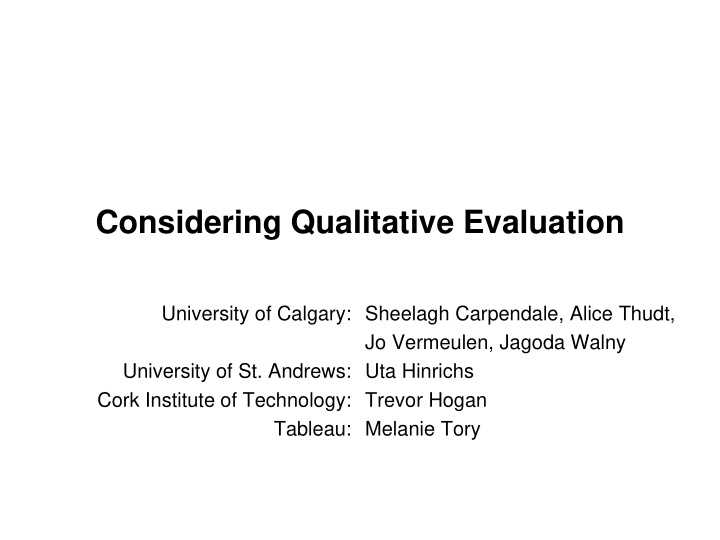



Considering Qualitative Evaluation University of Calgary: Sheelagh Carpendale, Alice Thudt, Jo Vermeulen, Jagoda Walny University of St. Andrews: Uta Hinrichs Cork Institute of Technology: Trevor Hogan Tableau: Melanie Tory
Overview Talk 1: Setting the stage: qualitative Talk 2: Observation as a skill Activity 1: Practicing observation Activity 2: Interviewing 1 Activity 3: Interviewing 2 Talk 3: Interviewing as a skill Activity 4: Interviewing 3 Panel: open discussion Talk 4: In summary – next step analysis
Interviewing as a Skill
interviews as first-hand insight Discovery and Insight Experiences when interacting with visualizations Comparing experiences with different visualizations
the interview as part of a study • When to conduct the interview? • Interview structure/style • Challenges & pitfalls • Example types of interview questions • Data collection
interview vs. questionnaire • Questionnaire – For gathering brief feedback on well-defined questions – E.g., Multiple choice questions or ratings through Likert scales Answers from questionnaires are easy to summarize and quantify • Interview – If different interpretations/perspectives on questions are likely – If questions will likely trigger more elaborate answers Interview enables follow-up questions • Combinations are often useful
when to conduct the interview? • After the event of interest • In-between events of interest • During event of interest think-aloud protocol Discovery and Insight Comparing experiences with different visualizations
interview structure/style • Structured – Pre-defined interview questions – Every participant gets the same questions • Semi-structured – Pre-defined core questions – Follow- up questions depending on participants’ answers • Open – Questions openly evolve around a particular topic – Strongly influenced by participants’ individual experience
interview structure/style • Linear style • Iterative style The Elicitation Interview Technique: Capturing People’s Personal Experiences of Data Representations. T. Hogan, U. Hinrichs, E. Hornecker InfoVis Papers: Evaluation (last talk) Wednesday 10:30-12:10, Key 3+4+6
challenges & pitfalls • Participants – Post-rationalization – Pre-assumptions about experience & study – Seeks a positive communication with interviewer • Interviewer – Pre- assumptions about event and the participant’s experience – Asks biasing questions – Dominates the interview – C hallenge the participants’ memory – Showing agreement or disagreement with the participant – Judges the participant (worst case)
know your own bias • Think about and write down your own assumptions and biases • Example questions – What do you really want to find out from the study? – What do you think will come out of the study? – What is your relationship to the space, environment, prototype, people your study focuses on? – What are your assumptions about participants’ background, opinions, behaviour...? – What are your assumptions toward the prototype your are studying? – Are there any other potential areas of bias that you bring with you?
allow for silence • Let the participant gather their thought • Be comfortable with the silence • Project curiosity and empathy
let the participant talk • Start with brief open-ended questions • Let the participant describe their experience in their own words • Then ask more specific follow-up questions General questions More specific questions
practice your interview • Really know the core questions/topics you want to ask about – Always formulate them in the same way – In case you get side-tracked, know the topics you want to get back to • Practice how to formulate follow-up questions • Develop an awareness for “trigger” words – Asking follow-up questions – Asking for an example
thoughts on interview questions • Ask one question at a time • Avoid leading questions “ Did you find the visualization easy to use? ” Better: “ How did you find interacting with the visualization? ” • Try to use the same words used by the participant “ You mentioned that you found the visualization to be “confusing” – can you explain what you found “confusing”? ” • Ask for concrete examples • In longer interviews, summarize points that were mentioned and ask the participant to correct or add points
thoughts on interview questions • Content-less “When you saw the visualization, what did you do ?” • Clarifications on vague language “You mentioned the visualization was really “fun” – what was “fun” about it?” • Examples “You mentioned you have used this visualization as part of your work? Can you describe the last time you have used it?” “Was this a typical situation?” • Comparative “How would you describe Vis A and Vis B in comparison?”
individual vs. group interviews • Group interviews – Essential for collaborative/shared experiences – Can put participants at ease – Can trigger richer view points and discussions Influence of social dynamics within the group • Mixed approaches – First individual, then group interview
data collection & analysis • Full audio recording (if possible) • Video recordings (often useful) • Questionnaires For straight- forward questions that can be “outsourced ” • Full word-for-word transcriptions are a MUST – Know thy data! – Direct quotes are your evidence! • Open coding for emerging themes – Thematic analysis – Collaborative coding if possible
Recommend
More recommend